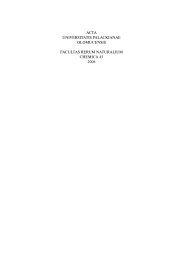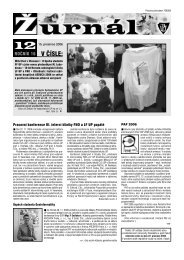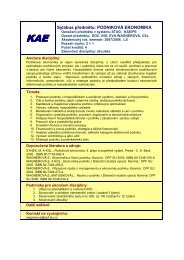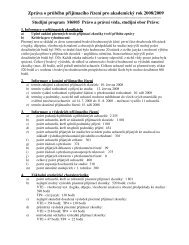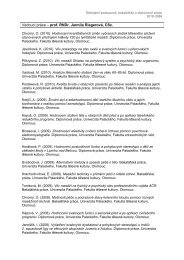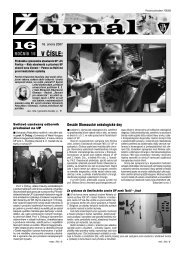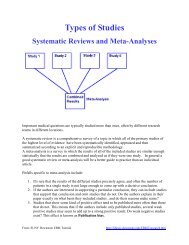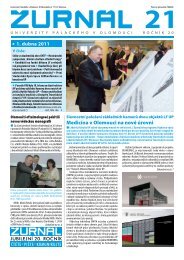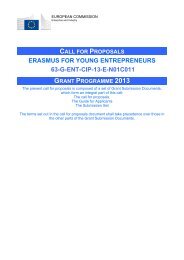ACTA UNIVERSITATIS PALACKIANAE OLOMUCENSIS GYMNICA ...
ACTA UNIVERSITATIS PALACKIANAE OLOMUCENSIS GYMNICA ...
ACTA UNIVERSITATIS PALACKIANAE OLOMUCENSIS GYMNICA ...
- No tags were found...
You also want an ePaper? Increase the reach of your titles
YUMPU automatically turns print PDFs into web optimized ePapers that Google loves.
20 Acta Univ. Palacki. Olomuc., Gymn. 2004, vol. 34, no. 2upright posture in a child, it is necessary to begin withits rectification. Unfavorable phenomena can be local orhave overall effects. Without rectification of the resultingmuscular dysbalances and bad locomotive stereotypes,pathogenic stimuli can cause the deterioration of balanceand, in the long term, can lead to changes in thetissue structure. In maturity, they manifest themselves aspainful vertebrogenic syndromes. Kolisko and Jandová(2002) point out that, at the present time, approximately70% of the mature population suffer from vertebrogenicdisorders.Upright posture assessment has theoretical as wellas practical significance. In practice, we have to assessposture in order to have an objective monitoring ofthe habit of upright posture, to classify pupils whenassigning them to remedial physical training programs,to evaluate the effectiveness of the remedial physicaltraining programs and to differentiate upright posturefrom deviations. Anthropometrical methods used for theassessment of monitoring of general growth and developmentof children are not fully sufficient for postureassessment. Ideal posture appears rarely and the transitionbetween upright posture and defective posture,as pointed out by Novotná and Kohlíková (2000), issmooth and often hard to define.Teachers, trainers, occupational therapy assistants,etc. need to know, at least in general, what is the stateof postural and phasic muscles involved in keepingposture correct.To be able to find the results of our posture improvementactivities, we have to assess the initial state of thechild’s posture expressed if possible in exact numbers.Lots of various methods have been developed tomeasure the quality of posture keeping: siluetographic,photographic, X-ray pictures, plaster casts, pantographicmethods (tracing the body silhouette with appropriatereduction on a paper), goniometric methods (usinggoniometers with gravitation protractors).Many examinations make use of instruments, but itis not always easy to carry them out in usual school practiceor remedial physical training programs. Thereforewe are satisfied with these practical and most often usedsimple methods based on visual observations – somatoscopicmethods – assessment of posture, general bodybuild and individual body parts, plus the shape of thespine and foot arch.METHODSThis study is a result of a research project whichforms a part of the Research Framework MSM154100020 “Research on the Somatic and PsychologicalState of the Czech Population with Applications inAnthropagogy, Pedagogical Psychology, Clinical Anthropologyand Ergonomics” for the period 1999–2003,carried out by the Department of Anthropology andHygiene of the Pedagogical Faculty of Palacký University,Olomouc.Within the transversal anthropological survey atseven primary schools of the Olomouc region in theperiod 2001–2002, the assessment of posture and footarches was carried out on 1201 probands (621 boys and580 girls) aged 7 to 15 years. For technical reasons,we chose the Jaroš and Lomíček (1957) somatoscopicmethod of posture assessment based on the evaluationof individual body parts, which is also recommended asthe most suitable by Přidalová (1997) who carried outher own survey of children in Olomouc, as well as byVařeková and Vařeka (1995).This method is easy, not time consuming, cheap,workable, with relatively maximum accuracy – i.e.results with minimum errors. Assessment is focusedon the following body parts: head and neck posture,thorax posture, abdomen posture with pelvis inclination,curve of the back, posture in the frontal plane, and assessmentof the lower limbs. Each assessed body partwas evaluated with a mark from 1 to 4. The foot archstate diagnostics were carried out using plantogramsin accordance with the Klementa (1987) method. Asa part of the survey, the examined children answereda questionnaire on their life style that brought informationon back pain during the day and pain in the areaof the spine where it occurs most often.For numeric processing of the results of postureevaluation and the questionnaire, we used mathematicalstatistics methods and Statgraphics Version 5 software.The statistical level of significance, so called Pearson’scorrelation coeffi cient, was used to fi nd out the relationshipbetween the age and the posture of probandsin particular age groups. The testing was on the 0.05significance level.RESULTS AND DICUSSIONThe results of the posture assessment of boys andgirls of school age, as for distribution and percentage ofoccurrence, do not imply a positive trend (TABLE 1, 2and Fig. 1, 2). For both sexes of all age groups, perfectposture occurs only sporadically. Perfect posture wasonly found in 5 boys and 6 girls. Very bad posture wasnot found in girls, only in one twelve-year old boy. Themost frequent categories are: II – nearly perfect postureand III – defective posture.From the results, the inter-sexual differences betweenthe posture of boys and girls are obvious (TABLE 1, 2).Girls of all age groups have better posture than boys ofthe same age. In category II – nearly perfect posture,there are 43.16% boys and 62.07% girls. In category III– defective posture, the relationship is inverse – 56%boys and 36.90% girls. The achieved results are in cor-



